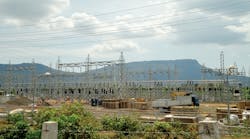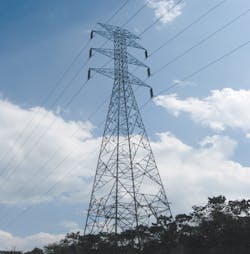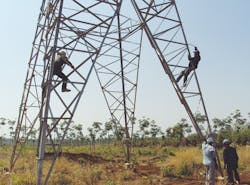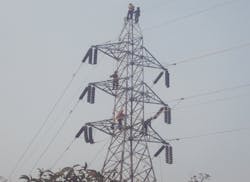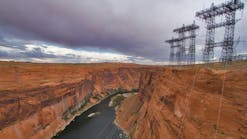Lao People’s Democratic Republic (Lao PDR) is a scenic, mountainous and highly forested landlocked Southeast Asian country with a beautiful landscape. This developing country has a population of about 6 million, the majority of whom live in the countryside.
The Laos government considers the development of the country’s vast hydropower resources to have significant potential to be a highly appropriate method of achieving sustainable economic growth and to meet the domestic electrification needs. In addition, the country exports surplus electrical energy to its neighboring countries of Thailand, Vietnam, Cambodia and China. Lao PDR has signed a power exchange agreement with Thailand and Vietnam to export 20,000 MW to Thailand and 2,000 MW to Vietnam before 2020.
Development of the country’s first hydropower plant began during 1970. The country now has a total installed capacity of 671 MW, of which 360 MW is currently being exported to Thailand and Vietnam. Lao PDR has a hydropower potential of 36,000 MW, of which around 18,000 MW is deemed to be technically exploitable.
Power Supply System in Laos
Electricite du Laos (EdL) is responsible for the management of the state-owned power system. Based on the variable geographical characteristics of the country, the existing transmission system supplying the whole country is operated as four distinct systems, namely the northern region, the central regions 1 and 2, and the southern region. Currently, Laos lacks a common interconnected transmission system, and the majority of villages are still without electrification.
The geographical conditions and availability of hydropower resources for the existing and planned hydropower plants (being installed to meet the rising domestic demand) are mainly located in the central 1 and southern regions. Therefore, the following power-supply strategy was developed:
- The central 1 region will supply the power requirements for the northern and central 2 regions.
- The central 2 region will supply the power requirements for the southern region.
To implement this strategy, the interconnecting transmission line transfer capacity between the regions required investments to fulfill the existing power-exchange agreements and to optimize the use of the system reserve margin.
Long-Term Development Plan
The demand for electrical energy in Lao PDR is increasing rapidly, based on EdL’s annual growth rate of 11%; the peak demand by 2020 is estimated to be 1,487 MW. According to the plan for increasing generating capacity for the period of 2007 to 2016, the installed capacity will be increased to 1,754 MW, of which 324 MW (18%) will come from investments by EdL, 882 MW (50%) from independent power producers for domestic demand (IPPd) projects, and 548 MW (31%) from independent power producers for exporting (IPPe) to neighboring countries’ projects.
During the same period, 25 substation expansion projects are planned: six in the northern region, 14 in the central 1 region, two in the central 2 region and three in the southern region.
The EdL development plan also includes the establishment of load-dispatch control centers to improve system operations in terms of reliability and stability. It also will realize economic benefits arising from the power purchase agreements established with the IPPs. Three load dispatch control centers are planned:
- Center 1 region in Khammoune Province, regional control center
- Capital of Vientiane, national control center
- Southern region in Champassak Province, regional control center.
Transmission System Reinforcement
The government of India sanctioned a soft loan of US$33 million to the Lao PDR Ministry of Energy and Mines for the construction of 115-kV transmission lines, and additional substation capacity at Bangyo, Jiangxai and Paksong in Champasak Province. Furthermore, the funding will be used to construct the Namsong hydroelectric project reinforcement and to purchase materials for the rural electrification program.
During the period of 2007 to 2016, EdL plans to increase the total length of the transmission system by 1,587 km (986 miles), which will include 400 km (249 miles) designed to operate at 230 kV. For the period of 2010 to 2016, the erection of transmission lines is estimated to be an additional 6,900 km (4,287 miles), of which 4,769 km (2,963 miles) will be owned by EdL and the remainder by the IPPs.
Substations
The three existing substations in Champasak Province were upgraded with support from Thailand and China.
The Bangyo substation — located in a village on the Thailand–Laos border some 8 km (5 miles) from Pakse City, the province’s capital — supplies the local network, Pakse City and the interconnector that exports surplus power to Thailand. This substation work was undertaken jointly by EdL and the Thai utility. An additional 115-kV incoming feeder bay was installed for the new 115-kV circuit to Jiangxai substation, as well as upgrading of the existing supervisory control and data acquisition (SCADA) system.
The Jiangxia substation is connected to two hydroelectric power plants, Xset 1 dam (45 MW) and Xset 2 dam (75 MW), and two existing substations, Bangyo and Ban Na. The completed reinforcement work included the addition of three 115-kV feeder bays, six 22-kV feeder bays, an additional 30-MVA, 115/22-kV transformer, and interconnection to the existing SCADA system. This substation work was undertaken by EdL using technology and imported materials from Thailand.
The Paksong substation, located 60 km (37 miles) from Jiangxai substation, was upgraded using Chinese technologies as well as equipment and materials imported from China. The Paksong substation, which also is supplied at 230 kV from the Xset 1 and 2 dam hydroelectric power plants, was extended by another two 115-kV feeder bays for the circuits erected between the Paksong and Jiangxai substations.
Overhead Transmission Lines
The 115-kV double-circuit transmission line from Paksong to Jiangxai a 42-km (26-mile) section, was constructed using single-peak, self-supporting galvanized steel towers. Initially, this line was planned and installed to transmit 75 MW from the Xset 2 power plant to supply the Paksong substation with surplus circuit load transfer capability for use in the future.
This section of the transmission line, routed through dense forest, agricultural land and deep valleys, had an average span length of 350 m (1,148 ft). Securing a right-of-way for this circuit proved challenging as, apart from paying government compensation to farmers of $250 per tree, the land was subject to unexploded bombs as a result of the country’s civil war from 1953 to 1975. Excavation of tower foundations revealed unexploded bombs up to 1.5 m (5 ft) below the ground level. The services of the UXO Global technicians were secured to clear unexploded ordinance. Construction work was halted until approval was received from the UXO that the line route was clear.
The Jiangxai–Bangyo 115-kV transmission line is routed adjacent to the highway, but, to comply with legislation, a separation distance of 35 m (115 ft) from the center of the highway was imposed. Securing approval for this right-of-way delayed line construction for two months.
Laos is a tropical environment subject to heavy rain; therefore, retaining walls had to be constructed for towers erected in hilly areas. Designed to follow the contour of the ground surface, these walls reduce construction costs and protect the tower foundations from excessive rainfall.
Project Management
In spite of all the unforeseen problems experienced in the construction of the transmission lines and substation reinforcement, the entire project was completed in the record time of 15 months, well ahead of the estimated contract completion period of 18 months.
The complete project was managed by the project management consultancy WAPCOS Ltd., a government of India undertaking. The successfully commissioned project was constructed by Angelique International Ltd., which employed local labor resources.
First Phase
This major investment in the Laos transmission system completes the first phase of the country’s long-term plan that will afford new supplies to the rural communities and strengthen the power exports through interconnectors to neighboring countries.
Dandu V.S.N. Raju ([email protected]) received a BS degree in engineering from the Regional Institute of Technology, Jamshedpur, Ranchi University. Prior to joining WAPCOS, he worked at Balaji Gears Ltd. Hyderabad and the Central Electricity Authority. Raju has held several appointments in the field of planning, design, construction supervision and project management for hydropower, transmission and distribution projects during his 22-year career with WAPCOS. Currently, he is general manager (electrical), responsible for project management consultancy services on hydro and thermal power plants, transmission and distribution projects in Burundi, Cambodia, Central African Republic, China, DR Congo, Germany, Lao PDR, Liberia, Mozambique, Norway, Sierra Leone, Togo and Zimbabwe. He is a member of the Institute of Engineers, a Chartered Engineer (India), the IEEE, the CIGRÉ Committee in India and the Solar Energy Society of India.
M. Manoj Kumar ([email protected]) was awarded a Bachelor of Technology degree in electrical engineering and a master’s degree in power systems from the National Institute of Technology, Triuchirapalli. He joined WAPCOS eight years ago and is now a senior engineer responsible for extra-high-voltage and high-voltage transmission lines and substation projects. Kumar has gained experience from working in India, Afghanistan, Bhutan, Burundi, Cambodia, Ghana, Lao PDR, Mozambique, Sierra Leone, Togo, United Kingdom and Zimbabwe. He is an associate member of the Institute of Engineers, a Chartered Engineer (India), the IEEE and the CIGRÉ Committee in India.
Companies mentioned:
Electricite du Laos | www.edl.com.la
Angelique International Ltd. | www.angelique-india.com
UXO Global | www.uxoglobal.com
WAPCOS Ltd. | http://wrmin.nic.in
